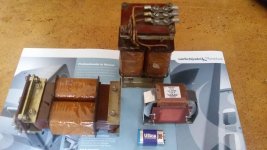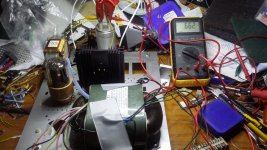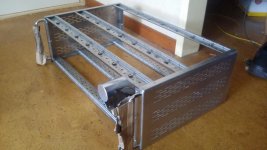That's a lot of iron!
That's why I'm asking myself if is necessary, actually I have 8 chokes for the PS... 🙄Maybe CRC filter will be enough for digital and BBB/WaveIO, without affect SQ ?
On digital I ended up moving from CLC to CRC as I ended up with too low a voltage with the drop across my choke. I can't say I noticed any decrease in SQ with this move on digital. I retained choke on the analogue side. I tried choke input as others have and again did not notice any improvement in SQ. YMMV
OK, I was lost! 😛
LL1638 8H and LL1694 1.5A received... and installed 😀
Left and right separated too, 2200uF -> LL1638 -> 2200uF -> LL1694 -> 2200uF, one line for one channel each choke in improved common mode rejection.
I don't know how can I explain what I am hearing, it is magic! 😱
Thanks again Doede and thank you also all crazy DIYers 😉
Julien, happy! 😀
Thanks for this data and the drawing very useful! 😀
What transformer are you using and voltage values as not stated in your picture please?
For the moment, I use old transformers where I remove wiring turns to get the right voltage at the end of PS. I can't tell you their voltage. When everything will be ok, I'll ask to my transfo/chokes builder to make an EI in M6X iron, with 4 differents secondary. I'm sure that she will be very happy 😀
Hello Julien,
Ask her to make a split bobbin. No need for static shield then. Transformers doesnt have to be that big. However the first choke cannot be big enough.
A pity for this dac is that the current with multiple boards and/or shunts will go way up so it is hard to get lots of Henry.
Still waiting for the new boards with incorporated shunts. Not really waiting i mean because i did start using the chokes for other purposes.
Greetings, Eduard
Ask her to make a split bobbin. No need for static shield then. Transformers doesnt have to be that big. However the first choke cannot be big enough.
A pity for this dac is that the current with multiple boards and/or shunts will go way up so it is hard to get lots of Henry.
Still waiting for the new boards with incorporated shunts. Not really waiting i mean because i did start using the chokes for other purposes.
Greetings, Eduard
I have replaced LCLC power supply for the BBB + Waveio by a CRC. It is still very good but I'm not sure that LCLC is useless. I should make an AB test for being sure. Do you think that I can use a commutator to switch between the 2 configurations without stop it between tests ?
Also, I have removed Cinemags ans connect POS and NEG directly to my "pot". Now it works perfectly, I have removed the wire between GND and RCA outer, no hum and perfect stereo, super ! And again a step in SQ. The bass are still tight but I feel that it has more impact, whereas my FE208Ez are not very good in this range of frequencies, great ! I think that I won more details too, I hear the mooth of singers now for example. 😀
I don't where all those things will stop to enhance but if it could continue, I'm happy 😉
Also, I have removed Cinemags ans connect POS and NEG directly to my "pot". Now it works perfectly, I have removed the wire between GND and RCA outer, no hum and perfect stereo, super ! And again a step in SQ. The bass are still tight but I feel that it has more impact, whereas my FE208Ez are not very good in this range of frequencies, great ! I think that I won more details too, I hear the mooth of singers now for example. 😀
I don't where all those things will stop to enhance but if it could continue, I'm happy 😉
Have a look at Dave Slagle's autoformer at $200 plus a couple hrs work you may get sota that you seek.
intact audio
I read Aurther Salvadore's analysis of EMIA volume control, took the plunge and bought the autoformers. I agree with his assessment.
REFERENCE COMPONENTS-Line Stages
Dave Slagle's autoformer received, connected to POS and NEG directly then to my amps but it doesn't work as it should, at -42dB the sound is too loud and strange, as it tries to remove voices.
I will contact Dave.
Dave's AVC works, I inversed left and right NEG... 🙄
Still a step in SQ, thank you wlowes for the advise, the main improvement is transparency and holography, some sounds come now far behind my speakers, wonderful !
Still a step in SQ, thank you wlowes for the advise, the main improvement is transparency and holography, some sounds come now far behind my speakers, wonderful !
One side of my DAC (single deck) has just stopped making sound, and on checking the outputs there is a 7.5v DC offset!
What could have gone wrong here?
What could have gone wrong here?
I would check the pin20 ccs and the i/v resistors. Compare the voltages and resistances of left and rightOne side of my DAC (single deck) has just stopped making sound, and on checking the outputs there is a 7.5v DC offset!
What could have gone wrong here?
Hello everybody !
Does anyone meets issue at low level sound ? I still have some kind of distortion when I listen music with low volume level, less than ALPS pot but still a little 🙁
Does anyone meets issue at low level sound ? I still have some kind of distortion when I listen music with low volume level, less than ALPS pot but still a little 🙁
Dave's AVC works, I inversed left and right NEG... 🙄
Still a step in SQ, thank you wlowes for the advise, the main improvement is transparency and holography, some sounds come now far behind my speakers, wonderful !
Great! Glad to hear you got autoformer magic going. They will actually get marginally better with time.
I hope you can sort out the distortion problem. Would a bad solder joint in the signal path cause this? might check around. I hope somebody who knows the circuit can help.
I have a Lampizator Level 7 in for some upgrades so took the opportunity to compare it to my souped up single decker DDDac. The Lampy is running some very expensive valves so we are talking about a UK price of £8000. Valves are KR Emissions Lab 5U4GB rectifier and PS Vane 101 replicas.
Frankly there is very little in it SQ wise. The Lampy has a marginally richer valve-like mid range (well, it would) whilst the DDDac is more transparent but slightly more analytical. The DDDac wins on digging detail but the Lampy is almost as good at painting a big picture. I think I would put the Lampy marginally ahead on female vocals and the DDDac ahead on more complex classical or rock music.Not bad for less than £1,000 of DIY and a little help from my friends!
But given that an i2s hook up to a Beaglebone or RPI gives another major lift in SQ there's an easy upgrade route for us DDDacer's whilst such implementation on the Lampy would be much more complex.
David
Frankly there is very little in it SQ wise. The Lampy has a marginally richer valve-like mid range (well, it would) whilst the DDDac is more transparent but slightly more analytical. The DDDac wins on digging detail but the Lampy is almost as good at painting a big picture. I think I would put the Lampy marginally ahead on female vocals and the DDDac ahead on more complex classical or rock music.Not bad for less than £1,000 of DIY and a little help from my friends!
But given that an i2s hook up to a Beaglebone or RPI gives another major lift in SQ there's an easy upgrade route for us DDDacer's whilst such implementation on the Lampy would be much more complex.
David
Chokes
Hello,
Because i did use or did decide to use in the near future for other projects i had to get some new chokes for my future dddac.
I did find these in a surplus store . One is 2×97mH the other one is 2×660mH . They can be connected the same way the lundahls are connected( differential mode).
Current rating is high enough to use a few boards with shunts. At the time these were made by Telefunken copper prices were not that high so thick wire was not an issue.
The lundahl in the pic is the ll2733 which will be used for heater supply in a vt25 tube amp.
Greetings, eduard
Hello,
Because i did use or did decide to use in the near future for other projects i had to get some new chokes for my future dddac.
I did find these in a surplus store . One is 2×97mH the other one is 2×660mH . They can be connected the same way the lundahls are connected( differential mode).
Current rating is high enough to use a few boards with shunts. At the time these were made by Telefunken copper prices were not that high so thick wire was not an issue.
The lundahl in the pic is the ll2733 which will be used for heater supply in a vt25 tube amp.
Greetings, eduard
Attachments
I hope you can sort out the distortion problem. Would a bad solder joint in the signal path cause this? might check around. I hope somebody who knows the circuit can help.
Did some tests this morning.
The problem do not come from Dave's AVC, I have try to replace it by previous attenuator, the problem is the same.
The problem is not my amps, I have tried them with an other source, no issue with it.
At low volume level, I have strange noise get out from my speakers, which come, leave, come, leave... :
http://djudju.net/DIY/DAC/Noise.wav
Quality is not good (caught from my cell) but we can easily hear it.
Noise is on I2S but also on SPDIF, but, if I switch off WaveIO on i2S, it stops. On SPDIF side, noise is there even if I unplug the input cable.
I have try to disconnect ethernet cable on BBB, problem still there.
I'm asking myself if I don't have a kind of ground loop, all PS ground are connected each togother on the main board thanks to PCB traces but not outside.
Billyboyk
Can you describe the entire audio chain or show a picture. Then again describe when you hear the distortion and when you do not?
IE bbb->usb->WaveIO->DDDAC->slagleformer->amp?
Can you describe the entire audio chain or show a picture. Then again describe when you hear the distortion and when you do not?
IE bbb->usb->WaveIO->DDDAC->slagleformer->amp?
Billyboyk
Can you describe the entire audio chain or show a picture. Then again describe when you hear the distortion and when you do not?
IE bbb->usb->WaveIO->DDDAC->slagleformer->amp?
This is exactly that 😉
I have 4 PS:
One for BBB + WaveIO
One for DDDAC Digital
One for DDDAC Left Analog
One for DDDAC Right Analog
Evening all 🙂
Has anyone experimented with adding small ferrite beads in to their digital power supplies on the dac decks? We know that good quiet voltage supply can be key for these sensitive and high frequency digital devices, but even the best shunt and other low noise regulators will do very little noise filtering above about 150khz it seems, whereas the digital side of the dac chips operate well into the megahertz range. Surely there would be some benefit of using some high frequency noise filtering and separation from a simple ferrite on the power input either just before the regulator or just before the local decoupling cap? It seems simple and cheap and from what I've read it sounds ideal, but is there a reason it wouldn't be worthwhile or could even be negative?
Has anyone experimented with adding small ferrite beads in to their digital power supplies on the dac decks? We know that good quiet voltage supply can be key for these sensitive and high frequency digital devices, but even the best shunt and other low noise regulators will do very little noise filtering above about 150khz it seems, whereas the digital side of the dac chips operate well into the megahertz range. Surely there would be some benefit of using some high frequency noise filtering and separation from a simple ferrite on the power input either just before the regulator or just before the local decoupling cap? It seems simple and cheap and from what I've read it sounds ideal, but is there a reason it wouldn't be worthwhile or could even be negative?
Evening all 🙂
Has anyone experimented with adding small ferrite beads in to their digital power supplies on the dac decks? We know that good quiet voltage supply can be key for these sensitive and high frequency digital devices, but even the best shunt and other low noise regulators will do very little noise filtering above about 150khz it seems, whereas the digital side of the dac chips operate well into the megahertz range. Surely there would be some benefit of using some high frequency noise filtering and separation from a simple ferrite on the power input either just before the regulator or just before the local decoupling cap? It seems simple and cheap and from what I've read it sounds ideal, but is there a reason it wouldn't be worthwhile or could even be negative?
Hello,
In the original power supply there were 2 coils one before and one after LF80. I remember reading some people did remove them after start using shunts. I dont know if they were used in the digital supply as well?
After all i am not using this dac.
Of course one should use a decent power transformer. Split bobbin or R core with static screen to stop all kind of interferences right at the start of the power supply i think.
Of course a choke input with what Lundahl calls common mode connection can help too. Dont know if this will work for these ultra high frequencies?
I will try once the boards with integrated shunts appear for sale LOL
Now busy with my new to build single ended amp. As you can see also choke input. 65H inductance possible because of low current. Now will start making some metal parts to safely connect it together and put it into a bigger chassis.. As you can see high voltage present!
Greetings, Eduard
Attachments
- Home
- Source & Line
- Digital Line Level
- A NOS 192/24 DAC with the PCM1794 (and WaveIO USB input)


